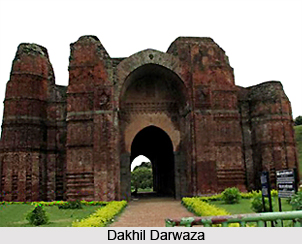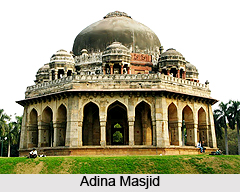 Provincial architecture under the Delhi Sultanate prospered in the hands of the Muslim rulers in the provinces. They built tombs, palaces, mosques, forts etc. in their kingdoms which were highly inspired by the Delhi or the imperial style of architecture. Due to limited financial resources, the provincial rulers could not afford the opulence to their building as was provided by the Sultans of Delhi. The local circumstances also influenced the provincial style of architecture.
Provincial architecture under the Delhi Sultanate prospered in the hands of the Muslim rulers in the provinces. They built tombs, palaces, mosques, forts etc. in their kingdoms which were highly inspired by the Delhi or the imperial style of architecture. Due to limited financial resources, the provincial rulers could not afford the opulence to their building as was provided by the Sultans of Delhi. The local circumstances also influenced the provincial style of architecture.
In Multan there are four notable buildings which were built during this period namely the shrine of Shah Yusuf-ul-Gardizi, the mausoleum of Bahlul Haqq, the tomb of Shams-ud-din and the tomb of Rukn-i-Alam built up by Ghiyas-ud-din Tughlaq. Among all these architectural specimens the tomb of Rukn-i-Alam has been regarded as the most magnificent one. In Bengal, mostly bricks were used in the construction of the buildings. The prominent buildings of Bengal are the Adina Masjid built by Sikandar Lodi at Pandua, the Eklakhi Mausoleum at Hazarat Pandua, the Gunamant and the Darasbari mosques at Gaur, the Lotan Masjid and the Bari Sona Masjid at Gaur, the Sath Gumbad mosque at Bagerhat (Khulna district), the tomb of Rukn Khan at Debikota, the Qadam Rasul at Gaur built by Nusrat Shah, the Dakhil-Darwaza at Gaur and the tomb of Jalal-ud-din Muhammad at Pandua. The most important features of the Bengal Style of architecture were the use of pointed arches on pillars, Hindu decorative designs and adaptation of Hindu architecture to Islamic art.
 The rulers of Sharqi dynasty at Jaunpur deeply patronised architecture and a number of good buildings were raised during their rule which were endowed with certain superior features of both the Hindu and Islamic architecture. The salient features of the buildings constructed in Jaunpur were square pillars, small galleries and absence of minarets. The fort and the palace of Ibrahim Naib Barbak are the most prominent specimen of architecture under the Delhi Sultanate. Among buildings constructed by the Sharqi rulers, are the Atala Masjid completed by Ibrahim Shah Sharqi, the Jami Masjid built by Husain Shah and the Lal Darwaza mosque which depicts the best features of provincial architecture. The buildings in Malwa bear similarity with those which were constructed by the Sultans of Delhi. The fort of Mandu has been regarded as a beautiful protected city. The most notable buildings of Mandu are the Jami Masjid, the Hindola Mahal, the Ashrafi Mahal, the tower of victory and the tomb of Sultan Hushang constructed by Sultan Mahmud Khilji, the Jahaz Mahal and palace of Baz Bahadur and his queen Rupmati. The buildings in Malwa have their own distinct style and occupy a respectable place among the architectural style of provinces during this period.
The rulers of Sharqi dynasty at Jaunpur deeply patronised architecture and a number of good buildings were raised during their rule which were endowed with certain superior features of both the Hindu and Islamic architecture. The salient features of the buildings constructed in Jaunpur were square pillars, small galleries and absence of minarets. The fort and the palace of Ibrahim Naib Barbak are the most prominent specimen of architecture under the Delhi Sultanate. Among buildings constructed by the Sharqi rulers, are the Atala Masjid completed by Ibrahim Shah Sharqi, the Jami Masjid built by Husain Shah and the Lal Darwaza mosque which depicts the best features of provincial architecture. The buildings in Malwa bear similarity with those which were constructed by the Sultans of Delhi. The fort of Mandu has been regarded as a beautiful protected city. The most notable buildings of Mandu are the Jami Masjid, the Hindola Mahal, the Ashrafi Mahal, the tower of victory and the tomb of Sultan Hushang constructed by Sultan Mahmud Khilji, the Jahaz Mahal and palace of Baz Bahadur and his queen Rupmati. The buildings in Malwa have their own distinct style and occupy a respectable place among the architectural style of provinces during this period.
In Gujarat the best combination of Hindu and Islamic architecture are found. The capital city of Ahmedabad was founded by Sultan Ahmad Shah and certain beautiful buildings were erected there. Most noteworthy buildings of Gujarat are the Jami Masjid at Cambay, the mosque of Hilal Khan Kazi at Dholka, the Jami mosque and tomb of Ahmad Shah at Ahmedabad, the tomb of Habit Khan and Sayyid Alam, the Tin Darwaza, the Rani-Ka-Hujra, the mosque of Dariya Khan and Alif Khan, the Dholka Masjid and the tomb of Shaikh Ahmad Khatri which is six miles away from Ahmedabad. The city of Champaner contains beautiful buildings and the mosque built up by Mahmud Begarha has been regarded as the best among them. Certain innovative features were added to the style of architecture of Gujarat during the rule of Mahmud Begarha.
In Kashmir, a pleasant blend of Hindu and the Muslim architecture was found. The most notable buildings constructed here during this period are the tomb of Mandani, the Jami Masjid at Srinagar and the mosque of Shah Hamadan. The rulers of Bahamani dynasty constructed splendid buildings within their territories. Their buildings represent a fair amalgamation of Hindu and Islamic architecture. The noteworthy buildings among them are the mosques at Bidar and Gulbarga, the tomb of Muhammad Adil Shah, known as the Gol Gumbaz, the Chand Minar at Daultabad and the college constructed by Mahmud Gawan at Bidar.






































